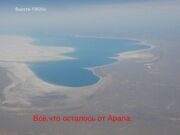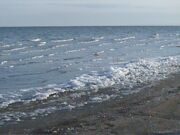 |
 |
 |
 |
| The Aral Sea drying off has become one of the planet's worst environmental disasters. | |||
Please click here to request the tour to the Aral Sea.
The Aral Sea drying off - planet's worst environmental disaster.
In the first half of the 20th century the Aral Sea was the world's fourth-largest inland saline body of water, with an area of 68 000 sq.km (42253 sq. miles).
The Aral Sea drying off has become one of the planet's worst environmental disasters. The remnants of the South Aral (Uzbekistan) continue to disappear and its drastic shrinkage has created the Aralkum (a desert on the former lake bed), that is covered with sea salts contaminated with pesticides and other toxic agricultural chemicals as well as bacteria and viruses. The farms in the Central Asian region used some highly toxic pesticides and other harmful chemicals. For decades, these chemicals have been deposited into the Aral Sea. When the wind blows across the dried-up sea bed, it carries dust containing these toxic chemicals.
As water has been drained from the rivers for cotton farming, the sea's water has become much saltier. As more water has been taken from the rivers, the sea's water level has decreased by over 60%. The abuse of the rivers, main arteries of the Aral actually started in 1930's, with the mass construction of irrigation channels. But in the years of 1960, the agricultural land area has doubled, so did the water consumption.
The Aral Sea degradation is a result of humans’ thoughtless, cruel and aggressive usage of the nature, including scope of other problems (ecologic, biologic, climate, soil and social).
Lakes and seas tend to have a moderating effect on the climate. In other words, the land right next to a body of water tends to be warmer in the winter and cooler in the summer than land that's not near the water. As the Aral Sea has lost water, the climate has become more extreme, summer is hotter and dryer and winter is colder.
In the result of the Aral Sea shrinkage a lot of living forms which occupied water and seashore are disappeared totally.
Aral (former Aralsk, Kazakhstan) town and Muinak (former sea port, Uzbekistan) town are separated from the sea by 25 km and 100 km respectively, of semi desert land, and people left these towns because of the lack of drinking water. From the end of 1980 in Aral region is recorded high level of unemployment.
The Sea rapidly became shallow. In 1989 the Aral Sea had already been divided into the two parts. In 2003 square of water surface decreased to 75%, and water capacity diminished to 90%. The Soviet Union collapsed, and became impossible to realize grandiose plans to redirect some of Siberian Rivers to Central Asia to save the Aral Sea in nowadays. That is obviously it is too difficult to save the Aral Sea, and if the Central Asian countries decide to stop water withdrawal from Amu Darya and Syr Darya rivers for agricultural necessities – then requires around 200 years to fill the Aral Sea. In 2003 Kazakhstan constructed Kokaral Dam and separated the small northern part of the Aral Sea from the southern part. Due to the Dam absolute water level in the Small Aral Sea (Kazakhstan) increased to 42 meters, and fishery getting revives. The big southern part of the Aral Sea (Uzbekistan) is destined to dry off, unfortunately.




